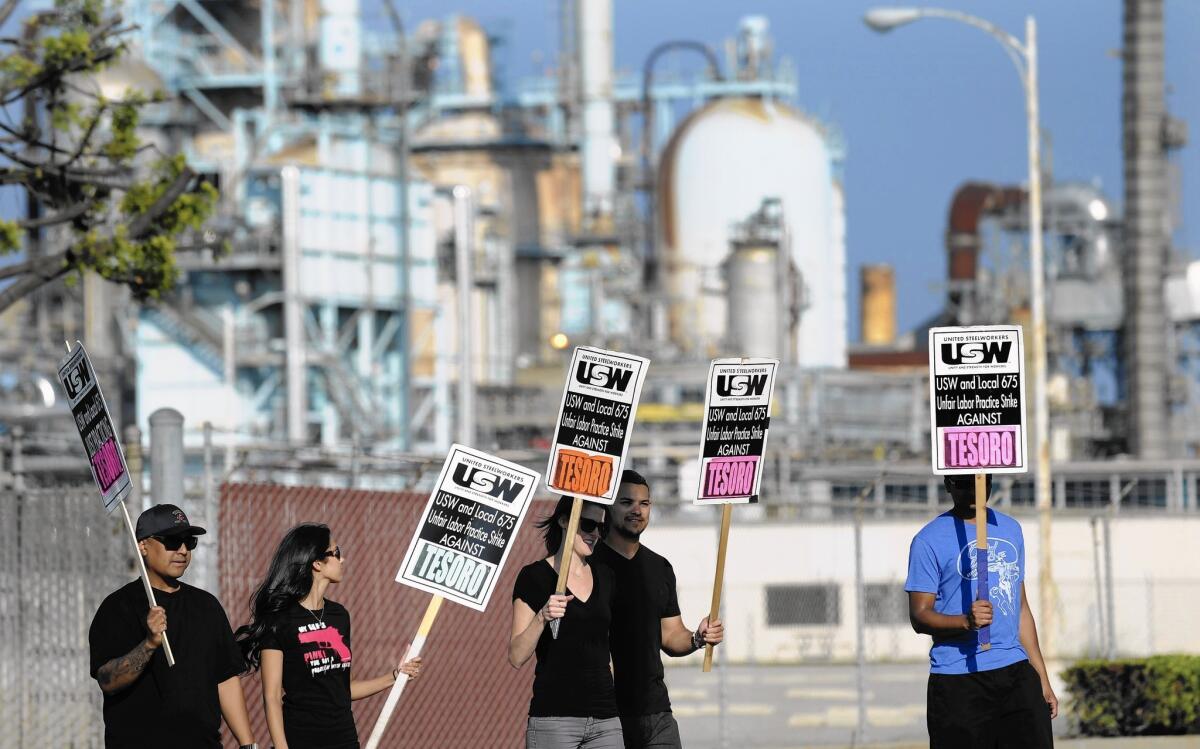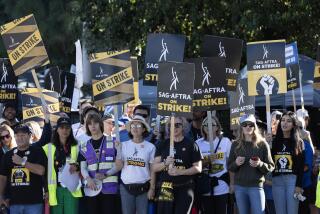At L.A. oil refinery, striking workers vent about long hours and stress

Hanz Zalamea got used to leaving work grumpy and dazed, like a college student after an all-nighter.
Before going on strike from the Carson portion of Tesoro Corp.’s Los Angeles oil refinery — one of 15 striking plants nationwide — he often worked several straight 12-hour graveyard shifts in the hydrocracker unit.
He monitored machines handling temperatures many times hotter than boiling water and equipment applying more than 1,000 pounds of pressure. Zalamea, 38, regularly left about 5:30 a.m., not long before he had to drive his young children to school.
“It’s depressing,” he said. “Sometimes I don’t feel like I’m all there.”
Worker fatigue and safety are key sticking points in the weeks-long strike, according to Zalamea and other members of the United Steelworkers union. They cite low staffing levels, long hours and hiring policies that allow too many contractors unfamiliar with the plant.
More than 6,500 employees nationwide — about 800 of them in Carson — walked out this month after a three-year contract covering 30,000 workers expired. So far, the union has rejected seven proposals. The last strike of such magnitude, in 1980, lasted as long as five months at some refineries.
A dozen of the plants affected by the current strike are responsible for nearly a fifth of U.S. oil refining capacity. Three of the facilities belong to Tesoro: the Carson facility, a plant in Washington state and one in Martinez in the San Francisco Bay Area.
The Carson facility continues to operate. Non-union workers and managers trained for months as part of a contingency plan for a strike and swung into position as soon as the walkout began, said David L. Foster, vice president of the Los Angeles refinery.
The main downside, he said, is that long-term improvements for the refinery are being delayed.
But Tesoro said it decided as a safety precaution to idle processing at the Martinez plant, half of which had already been undergoing planned maintenance before the strike.
The effect of the shutdown — along with damage from an explosion Feb. 18 at ExxonMobil’s refinery in Torrance — has caused gasoline prices in California to soar 60 cents a gallon since early February, according to consumer watchdog groups. Prices now top $3 for the first time this year.
The explosion, which blanketed the facility in ash and hospitalized four contractors with minor injuries, was caused by excess pressure in a piece of equipment.
Tesoro spokeswoman Tina Barbee called safety a “core value” of the company. Last year was the safest year on record at the Los Angeles operation, she said. Signs around the refinery implore workers to “do it safely or not at all.”
“There are inherent risks present in an industrial environment, and therefore a vigilant approach to safety must always be taken,” Barbee said in a statement.
The striking workers love many aspects of their jobs. Statewide, refinery employees earn about $20,000 more a year than the average Californian — not including extensive overtime pay. Many employees own nice houses and drive nice cars. When schedules cooperate, some head straight to the airport after shifts for a quick jaunt to the Northwest, Mexico or Europe.
“It’s not about the money,” said USW member Norm Rogers, who isn’t earning a paycheck during the strike.
Rogers, 53, has worked nearly 16 years in storage and handling of crude oil and finished products at the Los Angeles refinery.
The 900-acre operation, which includes the Carson facility and a sister plant in neighboring Wilmington, can process as much as 363,000 barrels daily.
Refinery safety has come a long way, Rogers said, “but only because a lot of folks have died.”
Refineries often take shortcuts or delays when repairing equipment, he said. New safety measures are commonly implemented only after catastrophic events, such as a 2005 blast at a BP refinery in Texas City that killed 15 workers, he said.
At the Carson site, employees don hard hats, personal chemical-detection meters and blue Nomex coveralls resistant to flash fires.
“You don’t realize after awhile how stressful it can be, and that you’re gritting your teeth,” said Rogers, who said he rolled his ankle on a pipe in a poorly lighted area a few years ago.
Zalamea, the hydrocracker worker, grew up near the refinery’s rust-bronzed spires. His wife was raised in Wilmington, where the sister Tesoro facility was rocked by several fires and explosions when it was owned by Texaco in the 1990s.
She still remembers the broken windows and bleating alarms.
Sometimes, though, the dangers in a refinery are far from obvious, Zalamea said.
Operations run 24 hours, every day. Employees usually have several 12-hour shifts — a few at night, a break in between and then a few during the day — followed by a few days off.
Tesoro says it sets shift and overtime limits that follow fatigue management standards set by the American Petroleum Institute trade association. But many workers complain that, because of chronic understaffing and retirements, they’re constantly on call and being summoned for unexpected overtime shifts.
“The big hours at 25 years old feel different than they do at 55 — it drags on you,” Rogers said.
Sometimes, employees said, shift schedules prevent them from seeing daylight for nearly a week. Anxiety leaves their limbs numb or tingly, their eyes watery. They down energy drinks and coffee. Getting caught dozing could affect their bonuses, they said.
The company said that although naps are allowed during designated meal and rest periods, sleeping on duty is prohibited because “it is dangerous to co-workers and to the community.”
Employees say the exhaustion feels like being jet-lagged, oxygen-deprived or drunk. Others complain about high blood pressure from the stress and diabetes caused by midnight snacks.
And to keep the facility’s injury rate from affecting their bonuses, many said they hide wounds from managers — a practice known as “bloody pockets.”
Barbee, the spokeswoman, said Tesoro expects all workers to report any incidents or “near misses.” The company uses a pay-for-performance compensation strategy that recognizes employees who contribute to the company’s goals, with safety being a key one, she said.
The USW also wants Tesoro to hire more union members to handle daily maintenance and repair work instead of contractors.
The contractor issue — not safety — is the main reason negotiations are stalled, said Keith Casey, Tesoro’s operations chief.
In a letter to employees this week, Casey accused the USW of trying to increase its dues-paying membership by limiting contractors. Tesoro, he said, needs contractors for specialized tasks or to adjust to fluctuating schedules.
National spokeswoman Lynne Hancock declined to specify the union’s goals for staffing levels but said the union isn’t trying to get its members jobs in new construction or work that requires specialty equipment.
“You can hire new people and raise the number of bodies, but you can’t hire institutional knowledge,” Rogers said.
As the strike wears on, Tesoro officials said that only trained, certified people are working, and they are confident in the refinery’s ability to operate safely and honor client commitments.
But some employees at the site are concerned.
Managers who haven’t worked on the floor for years are filling in for striking employees, said one worker, who asked to remain anonymous out of fear of reprisals from superiors. Some operators have refinery experience, he said, but not at the Carson plant.
“Others have no operations experience at all — we’re not sure where they’re from,” said the worker, who is among those working during the strike.
Some units shut down briefly in the first weeks of the strike and took longer than usual to get back up and running, the worker said.
“There’s a lot of concern in here right now,” the worker said. “If we had a major upset right now, these people may not be able to catch it in time like an experienced operator would be able to — they’d be chasing their tail.”
In the North Area Control Room, dozens of monitors gleam in a dim space that smells faintly of food. Diane Moreno, 59, keeps an eye on activity readings from the steam plant.
Until she became a manager in June, Moreno worked for 16 years as an union operator at the refinery. Now, she’s back doing her original job, filling in for colleagues and friends who are striking.
“It was initially stressful maybe on Day One, but it’s manageable” she said. “I’m disappointed, though — no one wanted this.”
Twitter: @tiffhsulatimes







